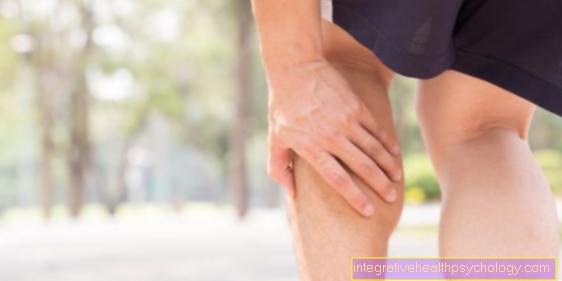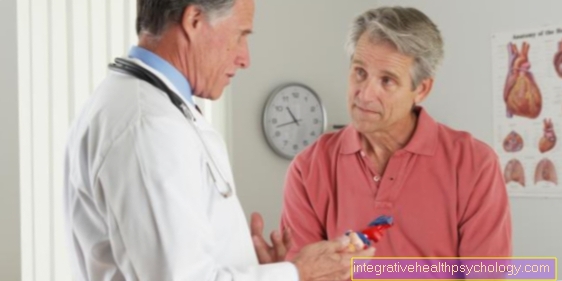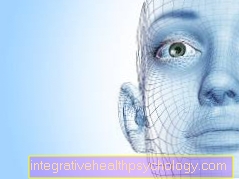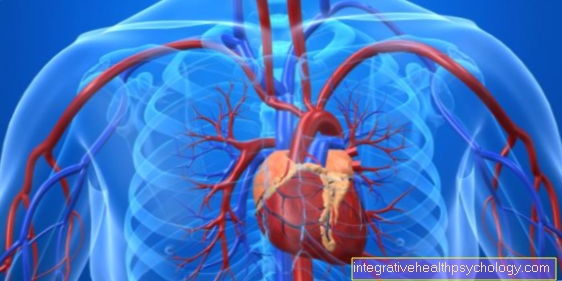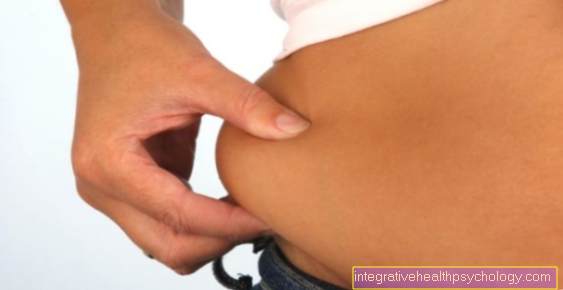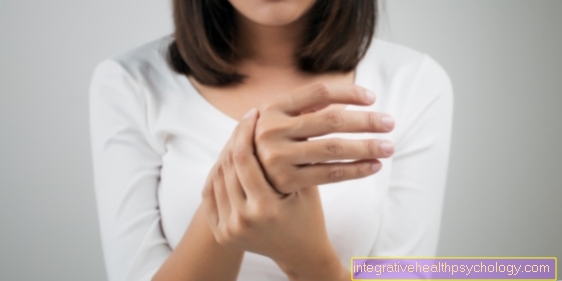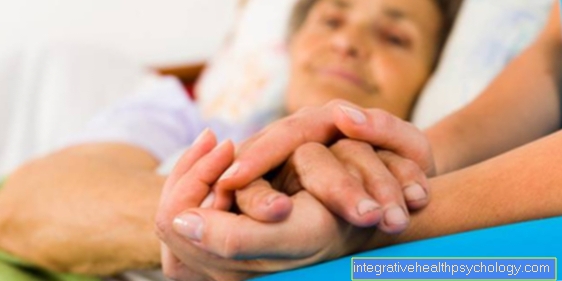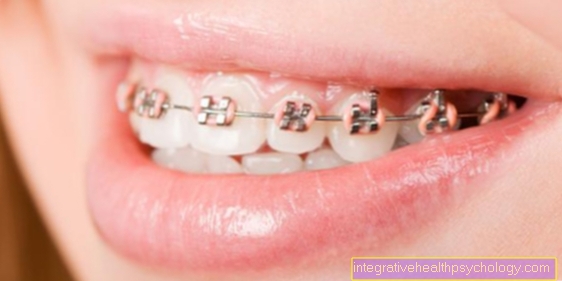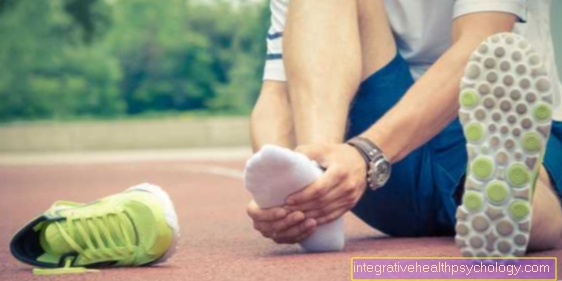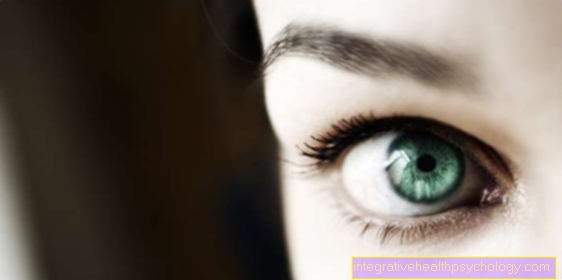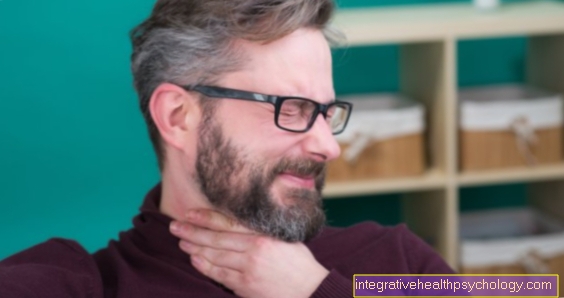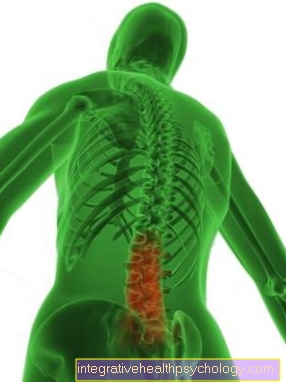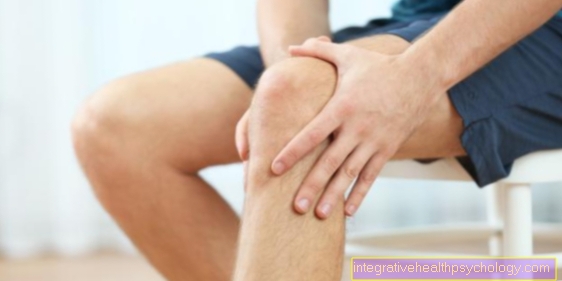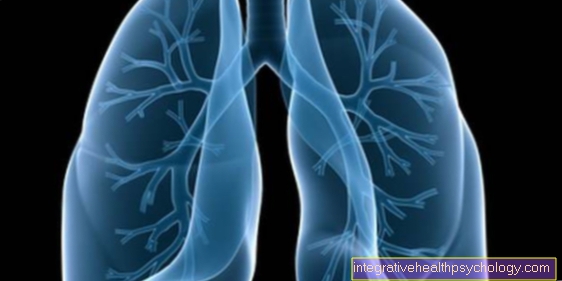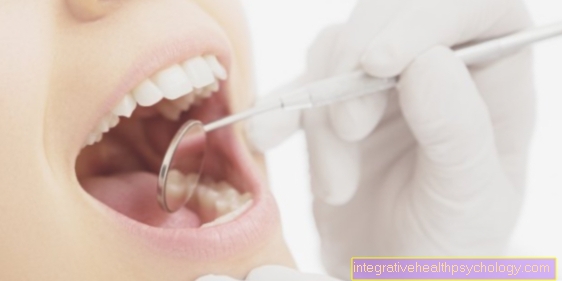Neck pain
introduction
Neck pain can have many different causes.
Posture problems and chronically overloaded, tense muscles are the main causes of complaints in the neck area. .
With increasing age, signs of wear and tear on the cervical spine come to the fore. This often not only causes neck pain but also often restricts the mobility of the neck.
Is your neck tense? Read more about this here: How can you best relieve neck tension?

Causes of Neck Pain
Medically, neck pain can be divided into four categories, depending on how it develops:
- Mechanically induced neck pain
- Non-mechanical neck pain
- Transmission pain and
- mentally triggered neck pain
1. Mechanically induced neck pain
Neck pain is most often triggered mechanically, that is, by tension and functional disorders of the neck muscles or by signs of wear and tear on the soft structures of the cervical spine (such as intervertebral discs or ligaments) or hard, bony structures such as the vertebrae.
Mechanically induced pain in the neck can also be caused by
- Injuries like whiplash
- Vertebral fractures
- Spinal instabilities or
- Malformations of the cervical spine (e.g. scoliosis)
occurrence. Neck stiffness can be an indicative symptom of meningitis (meningitis) or meningeal irritation, as reflex tension in the neck muscles occurs. The sensitive and inflamed meninges force a gentle posture of the neck, as every movement causes severe pain in the neck or head.
Furthermore can
- Wear on the intervertebral discs (Chondrosis and osteochondrosis) and vertebrae (Spondylosis)
- Injuries and
- Malfunctions
lead to mechanical restrictions in the neck area and thus to neck pain. The pain is often one-sided and radiates into the shoulder. Bad posture in everyday life and at work (e.g. years of computer or overhead work) promote these mechanical complaints. In the small joints between the vertebrae (so-called Facet joints) blockages can occur, then neck stiffness occurs, especially after periods of rest. The facet joints can also become inflamed and cause pain, often radiating to the shoulder and arm.
Read more about this under: Shoulder Neck Pain - What You Should Know About It
The pain is not caused by irritated nerve roots on the spinal cord (radicular cause of pain), but from the inflamed joints (pseudoradicular cause of pain). This can also lead to sensory disorders such as tingling and numbness. Complex changes in the cervical spine or circulatory disorders in the blood vessels leading to the head can cause neck pain that goes up to the back of the head. In addition, symptoms such as
- dizziness
- Ringing in the ears or
- Eye flicker may occur.
2. non mechanical neck pain
The non-mechanical neck pain is caused on the one hand by disorders of the small vertebral joints in the cervical spine and by certain diseases of the musculoskeletal system.
Rheumatoid arthritis (rheumatism), Bechterew's disease and some similar clinical pictures in the area of so-called seronegative spondyloarthropathies cause pain in the neck area.
Neurological diseases such as nerve paralysis and lesions of the spinal cord are just as rare. Inflammatory muscular rheumatism (e.g. rheumatism) can occur much more frequently in women over the age of 50 than in men. Polymyalgia rheumatica) not only cause neck, shoulder and hip pain, but also painful inflammation of the shoulder joints and wrists.
In addition to diseases in the cervical vertebrae and neck area, shoulder joint diseases such as shoulder joint arthrosis (Omarthrosis), Inflammation of the shoulder bursa, tears in the stabilizing shoulder tendons or other shoulder injuries lead to pain in the neck.
3. Transmission pain
Neck pain can also occur in the sense of a transference pain during pathological processes in certain organs. In addition, chronic neck pain can often be classified in the group of transmission pain, since so-called trigger points are located in the tense and hardened muscles, near which pain fibers (Nociceptors) that are switched to continuous operation and lead to the spread of pain.
4. Mentally triggered neck pain
Not infrequently, neck pain can also have a psychological cause (especially chronically recurring neck pain) or aggravated by psychological stress. Heavy loads at work or in everyday life promote tension and quickly lead to pain in the neck area.
Also in the so-called fibromyalgia syndrome, a complex clinical picture with various pain points on the body and other symptoms, one suspects, among other things, psychological triggers for the neck pain.
Internal diseases such as diseases of the coronary arteries in angina pectoris or a heart attack (Myocardial infarction) can cause shoulder or neck pain.
Appointment with a back specialist?

I would be happy to advise you!
Who am I?
My name is dr. Nicolas Gumpert. I am a specialist in orthopedics and the founder of .
Various television programs and print media report regularly about my work. On HR television you can see me every 6 weeks live on "Hallo Hessen".
But now enough is indicated ;-)
The spine is difficult to treat. On the one hand it is exposed to high mechanical loads, on the other hand it has great mobility.
The treatment of the spine (e.g. herniated disc, facet syndrome, foramen stenosis, etc.) therefore requires a lot of experience.
I focus on a wide variety of diseases of the spine.
The aim of any treatment is treatment without surgery.
Which therapy achieves the best results in the long term can only be determined after looking at all of the information (Examination, X-ray, ultrasound, MRI, etc.) be assessed.
You can find me in:
- Lumedis - your orthopedic surgeon
Kaiserstrasse 14
60311 Frankfurt am Main
Directly to the online appointment arrangement
Unfortunately, it is currently only possible to make an appointment with private health insurers. I hope for your understanding!
Further information about myself can be found at Dr. Nicolas Gumpert
Neck pain after fall
If you fall, you may experience neck pain, depending on the type of fall. These often occur when you fall on your head or shoulder. In principle, you should always consult a doctor after such a fall. Neck pain associated with a fall can be a sign of dangerous consequences.
For example, these often occur when there is whiplash. There is a risk that structures on the neck and neck have been injured. Particular care must be taken in the area of the spine, as injuries in this area can sometimes lead to paralysis. Therefore, these should be clarified by a doctor, especially if, for example, nausea, vomiting or symptoms of paralysis occur in the arms.
Find out more about: Whiplash
In the event of a fall with impact on the shoulder or an inept support, neck pain can also be caused by extreme muscle tension. In such moments of shock, the muscles may contract quickly and strongly. This can lead to pain in the neck area after the fall and can be treated with massage and physiotherapy.
Neck pain from train
If you sit too long next to an air conditioner or an open window in the wind, many complain of neck pain afterwards. This pain caused by the draft is caused by the cooled muscles. This creates tension that can be very painful for those affected. Therefore it should be avoided to expose the neck to direct cold for too long. To warm up the muscles, heat cushions can be helpful, which you can easily place on the neck while lying or sitting. In addition, relaxation and loosening exercises can help to relieve tension.
Read more on the topic: Progressive Muscle Relaxation
Neck pain from dental problems
In some cases, neck pain can also be caused by dental problems. Inadequate dental treatment, for example, can be considered for this. A poorly fitting prosthesis or crown can lead to misalignment of the jaw. This often leads to tension in the muscles, which can spread to the neck. Severe toothache, for example due to advanced tooth decay, can also lead to relieving postures and thus to neck pain.
Grinding your teeth can also be a possible cause. Neck pain as a result of craniomandibular dysfunction (CMD) is also possible. With this disease, there is incorrect loading in the chewing system with resulting overloading of the surrounding structures.
You can find detailed information on the topic here: Craniomandibular dysfunction
Neck pain with sore throat
There are a few medical conditions that can cause neck pain and sore throat. These include above all infections, such as a sore throat. This often leads to severe swelling of the lymph nodes that put strain on the neck.
A strong flu can cause similar symptoms. In rare cases, meningitis is also the cause.
There are many other symptoms such as fever, nausea and a very stiff neck.
Find out more about the topic here: Meningitis
Neck pain symptoms
Neck pain can occur in any age group, but becomes more pronounced with advanced age and is often associated with significant muscle tension. Radiation of pain in the direction of the shoulder and arm is possible, which can also lead to muscle weakness, sensory disorders and tingling.
In the case of radiation of pain, paralysis or impaired sensitivity, one speaks of a neck-shoulder-arm syndrome (Cervico-Brachial Syndrome), which is mainly caused by nerve irritation (herniated discs in the cervical spine, inflammation, tumors) in the area of the lower cervical spine.
The neck pain can temporarily improve and reappear after a while, and possibly intensified. Particularly long phases of tension (e.g. work on the computer) or unfamiliar overhead activities are often the trigger for acute neck pain. Very rarely, a neck-tongue syndrome occurs, which is characterized by attacks of the back of the head, in the area of the tongue and in the neck when the head suddenly turns.
The reason for this is probably a change in the area of the head joint, which irritates the second nerve root, which originates in the cervical spine. Especially when lying on the affected side, neck pain and muscle weakness in the shoulder-arm area are also possible at night, often triggered by irritation and inflammation in the area around the shoulder joint. In contrast, short-term numbness, which will soon subside, is more likely to be attributed to an unfavorable sleeping position.
Read more on this topic at: Neck pain with headache
It is not uncommon for the painfully tense neck muscles to lead to neck stiffness with complete blockage of the mobility of the cervical spine (torticollis, Torticollis) to lead.
A simultaneous occurrence of
- a headache
- dizziness
- Ringing in the ears or
- Visual disturbances
is called Cervicocephalic syndrome designated. Transmission pain does not arise in the neck (where it is felt), but elsewhere in the body. In the case of a heart attack, for example, it is not uncommon for pain between the shoulder blades and the neck to occur. Such transmission of pain is usually not dependent on movements of the spine, which can provide an indication of transference pain.
Read more on the subject at: Back of the headache
Diagnosis and course of neck pain
The possibilities of diagnostic examination are also very numerous due to the variety of causes of neck pain. In order to make the correct diagnosis of pain in the neck, some information from the medical history is important first (anamnese), as they give first indications of the causes.
The physical examination of the cervical spine with regard to local pain points, muscle tension and hardening as well as the assessment of the mobility provides further information on possible causes. Trigger points (stimulus points whose contact causes pain) can also be examined. A neurological examination may be required to rule out that the cause of the neck pain is a pinched nerve.
Imaging procedures such as
- Ultrasound (Sonography)
- roentgen
- Magnetic resonance imaging (MRI, nuclear spin) or
- Computed tomography (CT)
allow further insights into the painful neck area. If meningitis is suspected, a cerebrospinal fluid puncture is also performed to examine the cerebrospinal fluid.
Neck pain in particular due to muscular tension usually has a positive effect and disappears after a short time. If the causes of neck pain are signs of wear and tear, conditions after cervical spine injuries, neurological or rheumatic diseases, it often leads to a chronic course with phases of relative freedom from symptoms and phases of acute pain.
Therapy of neck pain
In the case of neck pain, treatment is always directed against the cause of the complaint, with physiotherapy and physical-therapeutic measures in the foreground. Tension-related neck pain usually subsides on its own after a few days to weeks. In the acute stage, symptomatic treatment with pain medication (NSAIDs, e.g. Voltaren®), cold or warm packs, and temporary relief of the cervical spine is required.
With the help of active movement and muscle strengthening, the person affected can often do their part to alleviate the symptoms or even to disappear completely. Physiotherapy, active muscle strengthening, acupuncture, TENS treatments or the direct administration of anti-inflammatory drugs to the neck area for pain relief are also possible. Physical current or ultrasound treatments promote blood circulation and metabolic processes in the tissue and can have a relaxing effect. Chirotherapy or manual medicine should only be used with extreme caution in the neck area due to the risk of nerve damage.
Relief of the neck area (e.g. after a whiplash) can be achieved, for example, by a neck seal made of foam (Schanz tie) or a more stable plastic neck collar. At night, the cervical spine can also be relieved by a neck roll or a correspondingly shaped neck pillow.
Depending on the cause of the neck pain, surgical treatment options are also possible. With modern spine surgery through to microsurgical and less stressful surgical techniques, there is now a wide range of therapeutic options.
Read more on the topic: Relax your neck
Exercises for neck pain
An exercise ball or roll is an effective exercise for relaxing the neck muscles. With the patient lying down, the balls or roll are placed under the back just above the buttocks. The legs are turned on. The stretched body can now be moved forwards and backwards with the legs. When moving forwards and backwards, the neck must remain stretched backwards, the gaze should be directed upwards towards the ceiling and the neck should be kept straight. Several repetitions should be done.
After a short relaxation break, the exercise should be repeated again. The purpose of the exercise is to straighten the cervical spine and the resulting de-compression.
Another exercise can be done while sitting. With the back straight, the two arms are bent to the right and left and the hands are folded behind the head. The right elbow should now be pulled to the left with slightly springy, gentle movements, while the upper body of the seated patient also turns to the left, while the left elbow is pulled to the right behind the head. This exercise should also be repeated several times. Here, too, the cervical spine is gently decongested.
The third exercise can be done on a wall. The person is sitting on a chair with both elbows bent and hands clasped at the back of the head. The head is brought closer to the wall until the elbows touch the wall. You should remain in this position for a moment.
Then you should try to pull your back towards the wall, keeping your cervical spine straight. Again, the exercise should be done gently. Again, some repetitions should be done. All exercises can also be used well in everyday life, e.g. also during a break from work.
Another exercise should also be done while sitting. The right ear should be gripped over the head with the left hand. The head should now be gently pulled to the left and held for a few seconds. Then proceed the other way around and pull the head (left ear) to the right with the right hand.
Taping
For many people who suffer from neck pain, taping the painful area helps. It is particularly effective for pain caused by tense muscles in the neck area. The tissue is subjected to a kind of massage by the tension of the tape strips. This pull is increased by moving the neck, as the glued skin is stretched.The whole thing happens without putting too much pressure on the neck.
In this way, the affected structures can be gently loosened and tension released. The tapes can also be worn in everyday life and are therefore a clever way to loosen the neck for as long as possible. In the case of severe pain, however, exercises to relax the muscles should also be done, if necessary as part of physiotherapy.
In order to carry out the taping with the greatest possible effect, it is advisable to seek advice from a shop or a physiotherapist.
Homeopathy / globules for neck pain
There are different globules that can be helpful for neck pain. However, depending on the severity of the pain, it should not be used as the sole aid. Rhus toxicodendron can relieve pain in the joints. Ruta Often used for neck pain, when migraines also occur. Colocynth is especially helpful when the muscles are tense.
Ledum is also a possible option for tension and pain caused by inflammation, such as rheumatism.
Neck pain with other symptoms
Neck pain and headache
It is often difficult to find out which came first as both symptoms can appear at the same time. Long-term neck pain often leads to headaches. Symptoms that extend from below to the back of the head are often given. Often times, pressure on the cervical spine can make the headache worse.
But sometimes it also happens that the patient first has a headache and for this reason moves into an unphysiological posture of the spine, which in turn leads to increased muscle tension in the cervical spine. This then leads to neck pain.
Neck pain caused by infections is feared. Meningitis leads to so-called meningism, in which headache and severe neck pain are reported. Patients are often unable to rest their heads on their chests, so action is required as it is a life-threatening condition. In rare cases, meningitis does not result in a headache, but only in neck pain and the inability to rest your head on your chest. The differentiation is often clinically difficult and a detailed neurological examination must be carried out by the doctor.
Neck pain and dizziness
Most people think that dizziness is caused by the circulation. However, this is not always true. If dizziness is associated with neck pain, it can also be responsible.
The reason for this are receptors that the body uses to orient itself in space and to maintain balance. Some of them sit on the neck and on the muscles in the neck area.
If the muscles become tense, false signals are sent to the balance organ, which is located in the inner ear. This often causes dizziness and in some cases even fainting.
To be on the safe side, it should be clarified whether there are other possible causes for the dizziness. If this is not the case, exercises for the neck muscles can help relieve the dizziness and neck pain. The focus should be on relaxation and loosening exercises so that the muscles contract less.
If dizziness occurs with neck pain after a fall, a doctor should also always be consulted to rule out that there is no more serious injury.
You may also be interested in this topic: Causes of dizziness
Neck pain and cold
Neck pain can also be a symptom of a cold. The cause can be inflamed paranasal sinuses, which can be very painful and can radiate into the back of the head and neck in addition to the forehead. In the case of a severe cold, in addition to the nose and sinus, the ears are often tight or painful.
All of this together can also cause the pain to spread to the neck area. Influenza-like infections lead to headaches and muscle aches even without a cold.
Since the cervical vertebrae are occupied by neck muscles, muscle pain, which is often only indicated in the arms and legs, can occur here as well. If you have a cold, you can prevent neck pain by trying to keep your nose and sinuses clear. Nasal spray and inhalation with salt water vapor help here.
In the case of neck pain of any kind, you should avoid wearing a neck brace or other fixing measures. Neck pain directly after an accident is an exception; a neck brace should not be used until an appropriate diagnosis has been made. Late treatment after whiplash should also be carried out without a neck brace, as this can quickly lead to muscle regression in the cervical spine area.
Neck pain and migraines
Occasionally, neck pain occurs along with migraine attacks. Either the migraine or the painful neck may have occurred first, as both can be mutually dependent.
The exact reasons for this have not yet been finally clarified. If there is pain in the head and neck area, the trigeminal nerve, an important cranial nerve, is also irritated. This represents a kind of connection between the brain and various structures of the head. This can cause additional pain.
You can find detailed information at: migraine
Neck pain and cycling
Neck pain can arise with all everyday movements. All activities in which the cervical spine is held very rigidly and for a long time in one position can lead to tension in the area of the vertebral bodies.
When riding a bicycle, the upper body is often bent forward while the head and cervical spine are stretched to look forward. For a short time this posture will not cause any discomfort. On long or regular bike tours, however, the corresponding complaints will increasingly occur if sufficient relaxation exercises and breaks are not taken.
There are special saddles that make it possible to maintain a reasonably straight position of the back while cycling, which not only relieves the cervical spine but also the entire spine.
The same goes for swimming. During the breaststroke, the head is held out of the water in a similarly unphysiological way, which leads to increased muscular strain. When swimming back, however, there is a relief of the spine.
Prophylaxis of neck pain
To prevent neck pain, monotonous loads and poor posture should be avoided. Overloading the neck muscles but also excessive rest such as bed rest can strain the neck and lead to pain. Targeted muscle training can be used to prevent neck pain and premature wear and tear on the cervical spine.
Muscle tension can arise, especially when doing sedentary work. Relaxation exercises, regular short breaks and relaxation exercises for the shoulder and neck muscles can have a preventative effect.
Drafts, moisture and cold as well as one-sided postures and movements (e.g. carrying shoulder bags) should be avoided. Ergonomically shaped neck rolls or pillows and the choice of an optimal mattress can prevent tension from unfavorable sleeping positions. Strong stress should be avoided or reduced as much as possible, as stress can increase tension in the neck area.
If the neck pain recurs or does not go away on its own, it is imperative that you see a doctor for clarification.
Anatomy of the neck
The most important structures of the neck region (Regio nuchae) are the cervical spine and neck muscles. The cervical spine comprises 7 vertebrae (Vertebrae cervicales), including the first cervical vertebra called Atlas and the second, Axis. These two cervical vertebrae form with the back of the head (Occipital bone) the upper and lower head joint.
One on each side passes through a bony canal in the cervical spine Vertebral artery (Vertebral artery) up into the skull. The cervical spine is the most flexible section of the spine, especially when it comes to rotational movements.
The neck muscles are divided into a front and a rear muscle group. It is for them
- rotation
- Tilt
- Diffraction and
- Extension of the head
very important.
Summary
Neck pain is one of the most common symptoms today. They occur both acutely and suddenly, but can also solidify and become chronic. One of the reasons for the increase in the frequency of neck, shoulder and back pain is above all the frequent ones sedentary workthat most people have jobs today. Neck is the slang term for the Cervical spine. The neck therefore belongs to the spine, which is responsible for the statics and stability of the human body.
If neck pain occurs, one must first see where it comes from. They are through Muscle tension Occurring neck pain is probably the most common cause, but there can also be serious and serious causes behind it. Above all, that should be mentioned here Herniated disc of the cervical spine or also the Meningitis.
Harmless neck pain is mainly caused by tension in the muscles in the neck vertebrae. There are numerous exercises to help relieve neck pain.





